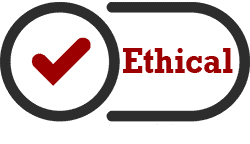This is the June 2021 edition of our monthly series of Ethics case studies titled What Do You Think? This series is comprised of case studies from NSPE archives, involving both real and hypothetical matters submitted by engineers, public officials and members of the public.
Your peers and the NSPE Board of Ethical Review have reviewed the facts of the case as shown below. And, here are the results.
Your opinion has been registered for the June 2021 edition of our monthly series of Ethics case studies titled What Do You Think?
Your vote is recorded as:

Want to know how your peers voted? We’ll send you an email with the poll results on June 29.
Your opinion has been registered for the June 2021 edition of our monthly series of Ethics case studies titled What Do You Think?
Your vote is recorded as:

Want to know how your peers voted? We’ll send you an email with the poll results on June 29.
A Review of the Facts
Engineer Mike, a licensed professional engineer, works for a utility company. Technician Sam works under Mike, and Sam becomes trained in the design of small single-story buildings. Eventually, Sam requires minimal supervision, but Mike carefully reviews and signs and seals all drawings and specifications as required by the local building authority.
During a company reorganization as a result of downsizing, Mike is transferred to another department and performs different activities and functions. Sam continues to design small single-story buildings and brings the plans and specifications to Mike’s department for Mike to sign and seal before bringing them to the local building authority for approval. Although not his direct supervisor, Mike follows the procedures used in the past, continues to direct and control Sam, reviews all of the documents prepared by Sam, and signs and seals them when he finds them to be correct.
Was Mike ethical in signing the documents as he is no longer Sam’s direct supervisor, nor is he even in the same department as Sam?
Here is the result of our survey of your peers:

Applicable NSPE Code References:
Code II.2.b: Engineers shall not affix their signatures to any plans or documents dealing with subject matter in which they lack competence, nor to any plan or document not prepared under their direction and control.Code II.2.c: Engineers may accept assignments and assume responsibility for coordination of an entire project and sign and seal the engineering documents for the entire project, provided that each technical segment is signed and sealed only by the qualified engineers who prepared the segment.
Code III.7: Engineers shall not attempt to injure, maliciously or falsely, directly or indirectly, the professional reputation, prospects, practice, or employment of other engineers. Engineers who believe others are guilty of unethical or illegal practice shall present such information to the proper authority for action.
Code III.9.a: Engineers shall, whenever possible, name the person or persons who may be individually responsible for designs, inventions, writings, or other accomplishments.
Discussion
Over the years, the Board has considered many cases relating to the basic principle of signing and sealing of drawings prepared either by the engineer, under the engineer’s responsible charge, or under other circumstances. This principle is one of the most fundamental concepts contained in the NSPE Code of Ethics because it identifies the engineer’s obligation to be responsible for his work and the work of those whom the engineer directs or supervises.
For example, in BER Case No. 86-2, the Board considered a case involving Engineer A who was the chief engineer within a large engineering firm who affixed his seal to some of the plans prepared by licensed engineers working under his general supervision who did not affix their seals to the plans. At times, Engineer A also sealed plans prepared by non-licensed graduate engineers under Engineer A’s supervision.
Because of the size of the organization and the large number of projects being designed at any one time, Engineer A found it impossible to give a detailed review or check of the design. He believed he was ethically and legally correct in not doing so because of his confidence in the ability of those he had hired and were working under his general direction and supervision. By general direction and supervision, Engineer A meant that he was involved in helping to establish the concept, the design requirements, and review elements of the design or project status as the design or project progressed. Engineer A was consulted about technical questions and he provided answers and direction on these matters.
In determining that it was unethical for Engineer A to seal plans that had not been prepared by him, or which he had not reviewed and checked in detail, the Board noted that the term “direction” contained in Code II.2.b. is generally defined as “guidance or supervision of action or conduct; management; a channel or direct course of thought or action.” The word “control” is generally defined as “the authority to guide or manage: direction, regulation, and coordination of business activities.”
The Board recognized that the role of a chief engineer in an engineering firm may be that of a “manager who provides guidance, direction, and counsel to those within his responsible charge.” Indeed, in a large engineering firm, this role is crucial to the successful operation of the firm. The Board noted that under the facts in Case No. 86-2, the chief engineer should be involved at the outset of the project in the establishment of the design concept and the design requirements, as well as in the review of the various elements of the design or project status as the design or project progressed. In addition, the chief engineer should also be available to consult on technical questions relating to the project design.
In contrast, five years later, the Board took a contrary position in a related case. In Case No. 91-8, Engineer A’s firm was retained by a major fuel company to perform site investigations in connection with certain requirements under state and federal environmental regulations. Under the procedures established by Engineer A’s firm, the site visits were conducted by engineering technicians (under the direct supervision of Engineer A) who performed all observations, sampling, and preliminary report preparation. The engineering technicians also took photographs of the sites. No professional engineers were present during the site visits. Following the site visits, all pertinent information and material were presented to Engineer A who was competent in the field. Following a careful review, Engineer A certified that the evaluations were conducted in accordance with engineering principles.
In concluding that it was ethical for Engineer A to certify that the evaluations were conducted in accordance with engineering principles, the Board reviewed its reasoning in Case No. 86-2 as well as Case No. 90-6, which involved an engineer’s signing and sealing of documents prepared using a CADD system. In Case No. 90-6, the Board had noted that in rendering its decision in Case No. 86-2, the Board raised considerable discussion within the engineering community because, to many, the opinion appeared to be inconsistent with customary and general prevailing practice within the engineering profession and would therefore place a significant number of practitioners in conflict with the provisions of the NSPE Code.
After concluding that the Board’s decision in Case No. 86-2 needed to be clarified, the Board noted that “customary engineering practice includes the use of engineering technicians, technologists, graduate engineers, and others to prepare preliminary reports, studies, evaluations, etc. with a professional engineer performing a careful review of all pertinent material and then signing and sealing appropriate plans and drawings.”
Turning to the facts in the immediate case, the Board understands the reasoning of the Board in deciding Case No. 91-8 and the realities of practice and the need for delegation for the performance of engineering services under the responsible charge of the engineer. The Board is not troubled by Mike’s actions. Although no longer his direct supervisor, Mike has direct day-to-day oversight control and supervision over the work of Sam. The Board is therefore of the opinion that it would be proper for Mike to sign the documents prepared by Sam under these circumstances.
It is not difficult to reconcile this decision with earlier Board precedents. The Board believes that there are important similarities between this case and previous Board determinations. For example, Case No. 86-2 involved work actually being performed by subordinates who were licensed engineers and presumably had and demonstrated the necessary education, experience, and qualifications to prepare the work that the senior engineer signed and sealed.
In addition, the Board believes this case presents a similar set of facts to those presented in Case No. 91-8, where the chief engineer had engineering technicians perform virtually all preliminary work, which the chief engineer certified was performed in accordance with engineering principles. This is because, under the facts, the engineering firm had established and followed clear procedures for the performance of the work.
Similarly, under the facts of this case, the actual design work is being performed by a non-engineer with substantial, actual, direct, personal supervision under the responsible charge of a licensed professional engineer. Sam and Mike are not operating under a loose, ill-defined structure, which could result in consequences for them as well as for their employer, the utility company. It is clear that the former relationship that existed between Mike and Sam would be consistent with the Board’s decision in Case No. 91-8, and it appears that the current approval process is an appropriate approval process.
The Ethical Review Board’s Conclusion

It was ethical for Mike to sign the documents prepared by Sam.
BOARD OF ETHICAL REVIEW
James G. Fuller, P.E.; William E. Norris, P.E.; Paul E. Pritzker, P.E.; Richard Simberg, P.E.; Jimmy H. Smith, P.E., Ph.D.; C. Allen Wortley, P.E.; Donald L. Hiatte, P.E., Chairman
Note – In regard to the question of application of the Code to corporations vis-a-vis real persons, business form or type should not negate nor influence conformance of individuals to the Code. The Code deals with professional services, which services must be performed by real persons. Real persons in turn establish and implement policies within business structures. The Code is clearly written to apply to the Engineer and it is incumbent on a member of NSPE to endeavor to live up to its provisions. This applies to all pertinent sections of the Code. This opinion is based on data submitted to the Board of Ethical Review and does not necessarily represent all of the pertinent facts when applied to a specific case. This opinion is for educational purposes only and should not be construed as expressing any opinion on the ethics of specific individuals. This opinion may be reprinted without further permission, provided that this statement is included before or after the text of the case.








Always interesting!
I disagree with the Board’s conclusion. Ethics for professional engineers are not subject to interpretation and are immutable. Although Mike followed a procedure that would be considered proper due diligence and would most certainly result in a desired outcome for the protection of the public health and safety, Sam was not working under his direct, responsible charge. This is the only conclusion a textualist can arrive at in review of this case.
The key statement is: Mike has direct day-to-day oversight control and supervision over the work of Sam.
R. Dell’Andrea: “Although not his direct supervisor, Mike follows the procedures used in the past, continues to direct and control Sam, reviews all of the documents prepared by Sam, and signs and seals them when he finds them to be correct.” This would be similar to a matrix-type organizational structure. It would be inappropriate for a requirement of only one type of organizational structure (needing to be a direct supervisor in a traditional organizational structure) in order to allow the involved parties to perform their actions.
Agreed. ADMINISTRATIVE supervision structure is irrelevant. Responsible charge requires the engineer to have direction, control and detailed review of the TECHNICAL work – and the rather limited description indicated that these lines of technical control were preserved despite the change in administrative organizational structure. This distinction is routine in large engineering consulting firms where engineers in responsible charge frequently direct project design teams whose members do not report to them for administrative supervision. The structure is designed around a common understanding that the engineer in responsible charge is the final authority on the design process & decisions on his/her project. Administrative supervision in this structure is a support function to provide appropriate personnel resources to the project design teams.
While Mike no longer has direct organizational (HR) oversight of Sam he still maintains engineering oversight. There is a potential risk if Sam is given direction by his non-engineering supervisor that is in conflict with engineering best practices.
Although the intent of Mike and Sam may have been honorable and perhaps ethical according to the ethics board, I disagree with the board’s opinion. What would happen if a) Mike made a mistake in his review of Sam’s calculations? or b) if the building specifications changed and Sam was unaware of such changes or c) if a failure of a system in the building, affected by Sam’s calculations, resulted in Sam being called into court? Would Mike then be liable? Would Sam and Mike be liable? Would the insurance company still be required to pay for damages? Too many unanswered questions and best for Mike NOT to put his seal on Sam’s work even if he thought it to be correct because he’s NOT the one overseeing the project.
I also strongly disagree. Dividing responsibilities between different departments is a recipe for disaster. Without a direct day-to-day overview of information feeding the design engineering, it is very likely that something will eventually be missed that was important, but that Sam missed.
I submit that, unless and until every conceivable ethical situation and every conceivable interpretation of language can be identified and codified, some level of judgement will be required. This case is no different. I agree with the Board’s conclusion but, I arrived at that conclusion from a different direction. That does not make my conclusion any more or less valid than the board’s.
John Brome: The scenario held that Mike and Sam followed the same procedures befoire the company reorganization, period. Under (1), there would be effectively no difference in the consequences than if he had made a mistakle in his review of Sma’s work during his tenure as Sam’s direct-line boss.
As for (2) of your comments: If buiilding specs had changed then it would still be required of Mike to be aware of these in any case; that’s not going to change if Mike goes from a direct report to dotted line report.
As for (3), Mike would still be liable, as it is his stamp, that never changes. Whether Insurance covers depends on exaactly what the company has for coverage.
Someone said: “Ethics for professional engineers are not subject to interpretation and are immutable.” Engineering Ethics are not morals. Morals, as I understand are immutable. Engineering ethics are subject to interpretation and change as the zeitgeist moves. As an example, in my twenties, and engineer could not advertise. Now in my eighties, an engineer can.
It is not clear that Mike responsible charge from the start of each of Sam’s activities. Mike would have to define the scope of Sam’s work at the outset, review any changed conditions and assumptions, etc. This conclusion is too loose and unfocused. I would never stamp any such work. in a similar case where i had a KY PE that i in which my supervisor wanted to save money on the project by excluding me from the specification of the geotechnical program at the outset; he only wanted me to review the final report and stamp it without any situational awareness. The board found my boss violated his professional engineer’s ethics and the laws of KY.
Disagree completely….this is not why the license and stamp were created for…. what is done here is “skirting” the regulations….the stamp and license was meant as to tool for a professional engineer to sell his services and to protect the public by ensuring that the structure is designed according to sound engineering principle …the stamp should only be used by the person performing the design…..in this case the designer should go get his own stamp…